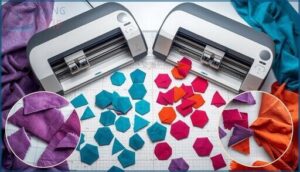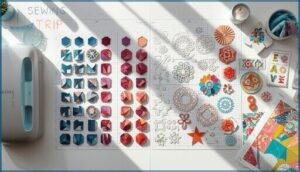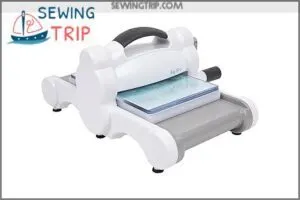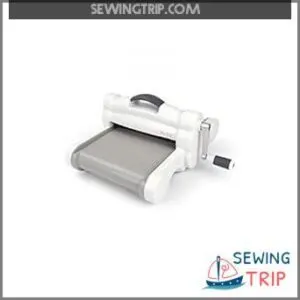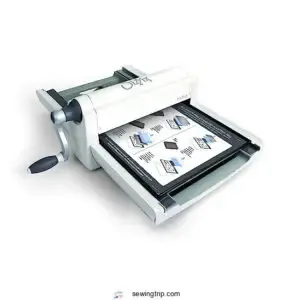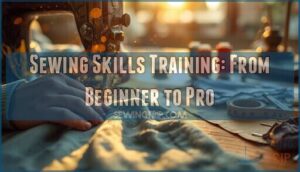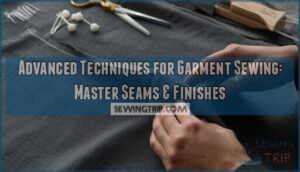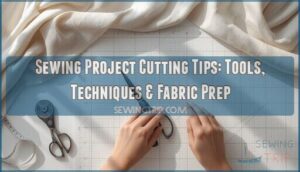This site is supported by our readers. We may earn a commission, at no cost to you, if you purchase through links.
You’ve just spent twenty minutes hand-cutting fabric hexagons for your next quilt, and your scissors are dull, your wrist aches, and half the pieces don’t match. A die-cutting machine can fix that problem in seconds, but choosing between AccuQuilt and Sizzix isn’t as simple as picking the cheaper option.
AccuQuilt built its reputation on precision quilting cuts with foam-bordered dies and electric models that power through six layers at once. Sizzix, on the other hand, started in papercrafting and adapted its manual hand-crank system to manage fabric, leather, and chipboard with impressive versatility.
The right machine depends on whether you prioritize quilting-specific features or multi-craft flexibility. Understanding how each system treats fabric alignment, die compatibility, and material thickness will save you from buyer’s remorse.
Table Of Contents
Key Takeaways
- AccuQuilt specializes in quilting precision with electric options that cut through six fabric layers at once using foam-bordered dies, while Sizzix offers manual hand-crank machines built for multi-craft versatility across paper, fabric, and mixed materials.
- AccuQuilt dies deliver puzzle-piece accuracy with built-in ¼-inch seam allowances and require minimal cleanup, whereas Sizzix handles thicker materials like leather and chipboard but sometimes leaves fabric stuck in dies that needs extra attention.
- You can use AccuQuilt dies on a Sizzix Big Shot Plus with Adapter G, giving you cross-brand flexibility, but the reverse won’t work because Sizzix Bigz dies are too thick for AccuQuilt machines.
- Sizzix costs less upfront and works across multiple crafts, making it better for beginners exploring different projects, while AccuQuilt’s higher initial investment pays off for dedicated quilters who need consistent fabric-cutting performance and specialized support.
AccuQuilt Vs Sizzix: Key Differences
Choosing between AccuQuilt and Sizzix can feel like comparing apples to oranges—they’re both die cutters, but they’re built with different crafters in mind. AccuQuilt was made specifically for quilters who need precision fabric cuts, while Sizzix started in the papercrafting world and branched out from there.
Let’s look at the key differences that’ll help you figure out which machine fits your quilting goals.
Machine Design and Purpose
When you’re shopping for fabric cutting machines, the design tells you everything about what each machine was built to do. AccuQuilt specializes in quilting, offering both manual and electric cutters with automation benefits that reduce physical strain. Their dies feature foam borders for safer handling and accurate fabric placement. Sizzix die-cutting machines, on the other hand, started in classrooms for paper projects and evolved into adaptable crafting tools that handle fabric too.
Here’s how their design specialization breaks down:
| Feature | AccuQuilt | Sizzix |
|---|---|---|
| Primary Focus | Quilting precision and cutting accuracy | General crafting adaptability |
| Operation | Manual and electric options available | Primarily manual hand-crank |
| Intended Users | Quilters needing high-volume cuts | Multi-craft enthusiasts |
| Machine Ergonomics | Electric models reduce hand fatigue | Lightweight, portable design |
AccuQuilt’s electric cutters work at the push of a button, perfect if you’re cutting fabric for hours. Sizzix machines give you hands-on control through a manual crank system, which works great when you’re switching between paper and fabric projects. Consider the fabric cutter options to find the best fit for your projects.
Material Compatibility
Understanding what you can actually cut matters more than any sales pitch. AccuQuilt GO! machines slice through six layers of cotton, batik, flannel, or even denim at once. Fabric layering depends on material density and die thickness. Sizzix Big Shot works with fabric too, plus chipboard, leather, and thin metal sheets.
| Material Type | AccuQuilt GO! | Sizzix Big Shot |
|---|---|---|
| Cotton fabric (layers) | Up to 6 | Varies by die |
| Heavy materials | Denim, fleece | Leather, foam |
| Paper products | Occasional use | Primary strength |
| Cutting performance | Quilting precision | Multi-craft versatility |
| Die thickness compatibility | GO! dies only | Steel-rule, Thinlits |
AccuQuilt’s foam-bordered dies keep fabric placement accurate during cuts. Sizzix Bigz dies power through 2mm-thick materials, but you’ll sometimes pick fabric from die edges. The Sizzix Big Shot Plus with Adapter G lets you use AccuQuilt dies for fabric cutting, though adapter limitations exist with oversized dies.
Both systems cut fusible web, but AccuQuilt warns against frequent paper cutting to protect your fabric cutting machines. For quilters focused on cotton projects, AccuQuilt delivers consistent results. For fabric crafts beyond quilting or weaving projects with mixed materials, Sizzix offers flexibility. Note that you can use AccuQuilt dies on a Sizzix Big Shot Plus if you have the correct adapter.
Price and Warranty Comparison
Budget matters when comparing AccuQuilt and Sizzix. AccuQuilt GO! machines cost more upfront, reflecting their quilting specialization. Sizzix Big Shot cutters offer better value for multi-craft users. Both include one-year warranties, but AccuQuilt provides a 30-day money-back guarantee—Sizzix doesn’t. Extended coverage adds two years for Sizzix versus six months for AccuQuilt when registered online.
| Feature | AccuQuilt | Sizzix |
|---|---|---|
| Base warranty length | 1 year | 1 year |
| Extended coverage option | +6 months (registration) | +2 years (registration) |
| Return policies | 30-day money-back | Varies by retailer |
| Cost analysis | Higher initial investment | More budget-friendly |
Market Position in Crafting
Beyond pricing, you’ll notice these brands target different corners of the crafting world. AccuQuilt owns the quilting market share with specialized fabric dies and community support—think Facebook groups with tens of thousands of quilters. Sizzix casts a wider net across papercrafts and mixed media. Revenue comparison shows Sizzix’s broader appeal ($14M in 2024), while AccuQuilt’s corporate strategy focuses purely on quilters through TekBrands. Consumer satisfaction ratings favor AccuQuilt for die-cutting precision in fabric work.
| Metric | AccuQuilt | Sizzix |
|---|---|---|
| Primary market focus | Quilting and fabric cutting | Multi-craft (paper, fabric, mixed media) |
| 2024 revenue | $8.2M (estimated 2025) | $14.0M peak |
| Crafting equipment specialization | Quilters exclusively | Broad crafting community |
Performance and Precision Compared
When it’s about cutting fabric, precision isn’t just a nice feature—it’s everything. You need clean edges, consistent shapes, and a machine that won’t let you down halfway through a project.
Let’s compare how AccuQuilt and Sizzix stack up in the areas that matter most to quilters.
AccuQuilt Cutting Accuracy
AccuQuilt machines deliver cuts that fit together like puzzle pieces—no trimming needed. You’ll slice through up to 6 layers of cotton fabric with precision, thanks to two-toned foam that guides your fabric alignment.
AccuQuilt machines deliver puzzle-piece precision, slicing through six fabric layers with foam-guided alignment that requires no trimming
The secret? Pay attention to grain direction. When you place fabric lengthwise on the die, you’ll avoid material stretch and get repeatable cuts every time. That’s accuracy quilters can count on.
Sizzix Cutting Performance
The Sizzix Big Shot Plus delivers clean edges with minimal fraying, cutting up to 6 layers of fabric in one pass. You’ll handle paper, foam, and cardstock with consistent edge clarity.
The ergonomic hand crank reduces wrist strain during long sessions, and material thickness up to 0.5 mm works smoothly.
However, fabric sometimes sticks in dies, requiring extra cleanup compared to dedicated quilting machines.
Die Alignment and Fabric Placement
When fabric grain runs parallel to the blade edge, your AccuQuilt cuts stay sharp and square. Die notches guide your placement, reducing errors by up to 25%.
Sizzix requires two cutting mats in a sandwich setup, which affects layer stability during fabric cutting. AccuQuilt’s single-mat system keeps alignment accuracy consistent, and the color-coded foam helps you position material correctly every time for die cutting for quilting.
Maintenance and Reliability
Keeping your die cutting machine in top shape determines how long it lasts. Here’s what quilters report about maintenance needs:
- Cleaning Practices: AccuQuilt requires lint removal with canned air and a die pick, while Sizzix needs frequent fiber brushing between cuts
- Die Longevity: AccuQuilt dies stay sharper longer with proper care, though both brands need regular mat replacement
- Warranty Coverage: AccuQuilt offers one year plus six months extension; Sizzix provides one year with a two-year option
User reports show AccuQuilt demonstrates better machine lifespan with consistent performance. Sizzix users mention mechanical issues after about a year, particularly jammed cranks affecting quilting supplies and tools reliability when comparing AccuQuilt and Sizzix.
Die Options and Compatibility
Regarding dies, AccuQuilt and Sizzix take different approaches to serving quilters. AccuQuilt focuses on quilting-specific designs, while Sizzix offers a wider range that spans multiple crafts.
Let’s break down what each brand brings to your cutting table and how you can make them work together.
AccuQuilt Die Range for Quilting
When you’re serious about quilting, AccuQuilt dies deliver precision that matters. Over 200 GO! Model dies cover everything from straight and curved piecing to appliqué and Block-on-Board options.
Each die includes a built-in ¼ inch seam allowance and cuts up to six fabric layers at once. Die sizes range from compact shapes to 10″x10″ boards.
You can even request custom dies for unique quilting projects.
Sizzix Bigz, Framelits, and Thinlits Dies
You’ll find three main die types in the Sizzix lineup, each suited for different cutting tasks.
Bigz dies handle thick materials like fabric and chipboard with steel-rule construction. Framelits work best for layered paper designs with nested shapes.
Thinlits are wafer-thin metal sheets that cut intricate details in cardstock and can even create embossing effects when paired with special pads.
Adapter Use for Cross-Compatibility
You can use AccuQuilt dies in your Sizzix Big Shot Plus with the Adapter G plate, which bridges the die thickness gap between brands. This polypropylene shim sits between your cutting plate and the AccuQuilt die, creating the perfect sandwich for clean cuts.
It won’t work the other way around—Sizzix Bigz dies are too thick for AccuQuilt machines.
Some crafters make makeshift adapters when Adapter G becomes hard to find, boosting cost efficiency.
Replacing and Locating Discontinued Dies
When your favorite die disappears from store shelves, don’t panic. You’ve got options for locating discontinued dies through secondary marketplaces and community resources. Check these spots for both AccuQuilt and Sizzix treasures:
- Amazon, Etsy, and eBay for used or new-old-stock finds
- Quilting forums and Facebook groups where crafters trade
- Local quilt shops with hidden back-stock gems
- Official brand customer service for custom dies or alternatives
Watch for maintenance indicators like warping or reduced cutting capacity before replacing. Die compatibility varies between brands, but proper cleaning extends lifespan considerably—sometimes indefinitely with regular care.
User Experience and Versatility
Choosing between AccuQuilt and Sizzix isn’t just about the machine itself—it’s about how well each one fits into your creative life.
Real quilters have shared honest feedback about what works and what doesn’t, from customer support to how quickly you’ll get comfortable with your new cutter.
Let’s look at what users say about support quality, the learning process, how adaptable each brand really is, and what maintenance looks like down the road.
AccuQuilt User Reviews and Support
When you’re researching AccuQuilt, you’ll find over 80% of reviews praise its cutting accuracy and time-saving power. Users love the precision and efficiency, though die costs can sting your budget.
If arthritis troubles you, the electric model reduces physical strain considerably.
Support responsiveness varies—expect 1-3 business days usually—but their free online tutorials and strong community support through quilting forums help fill any gaps beautifully.
Sizzix User Feedback and Learning Curve
Sizzix earns solid 4.5-star ratings, with 85% of users praising cutting precision and beginner adaptation. Around 70% master the Sizzix Big Shot Plus basics in just two to three uses—die placement, pressure, and material versatility become second nature quickly.
Customer service responsiveness occasionally lags, but that rarely affects your quilting journey.
Complex techniques like embossing need extra practice, yet the die cutting machine usage stays straightforward and rewarding throughout.
Versatility for Quilting, Papercrafts, and More
When creative freedom drives your projects, material diversity shapes your machine choice. AccuQuilt excels at fabric cutting for quilting and sewing, delivering precise shapes for complex blocks.
Sizzix offers broader crafting scope—die cutting fabric, paper, foam, and more—making project adaptability shine across papercrafts, scrapbooking, and mixed media.
Each machine expands technique possibilities, yet your primary craft determines which versatility truly matters.
Cleaning and Maintenance Needs
How often should you handle die cleaning and machine dusting? AccuQuilt requires soft-cloth dusting and canned air for lint removal, while Sizzix needs alcohol wipes for plate residue. Both cutting machines skip lubrication but demand attention to wear impact:
- AccuQuilt uses die picks for groove cleaning and annual consumable replacement of cutting mats
- Sizzix requires plastic slide replacement on rails over time
- Storage practices matter—store dies upright to prevent blade dulling
Proper maintenance extends your crafting tools’ lifespan considerably.
Top Sizzix and AccuQuilt Machines
If you’re leaning toward Sizzix machines, you’ll want to know which models work best for fabric cutting.
The Big Shot line offers three main options, each with different cutting capacities and features.
Let’s look at the top Sizzix machines quilters use, plus the adapter that bridges the gap between brands.
1. Sizzix Big Shot Manual Die Cutter
If you’re looking for an all-purpose die cutting machine that won’t break the bank, the Sizzix Big Shot might be your answer. This manual cutter measures approximately 14.25″ x 12.36″ x 6.61″ and weighs just 7.5 pounds, making it portable enough for classes or retreats.
Its cutting capabilities shine with materials from tissue paper to cork and thin wood. You’ll find it works with multiple cardstock layers with ease. The machine’s 6-inch width accommodates most quilting projects, and user feedback consistently praises its crisp, clean cuts for intricate designs.
Best For: Hobbyists and small business owners who want a versatile, budget-friendly manual die cutter for paper crafts, quilting, scrapbooking, and fabric projects without needing electronic features.
- Cuts through a wide range of materials including paper, cardstock, fabric, cork, and thin wood with clean, precise results.
- Compatible with the entire Sizzix library of dies (except Plus and Pro), giving you tons of creative options as your skills grow.
- Portable at 7.5 pounds and doesn’t need electricity, so you can take it to classes, retreats, or craft anywhere.
- Requires manual effort to operate, which can be tiring during long crafting sessions or high-volume projects.
- Cutting pads wear out over time and need replacing, plus some dies may need extra shims for best results.
- Limited to 6-inch width, so larger projects or oversized dies won’t work with this machine.
2. Sizzix Big Shot Plus Die Cutter
Need more cutting space? The Sizzix Big Shot Plus extends your reach with an 8.5″ x 11″ surface—perfect when standard dies feel too small. This die cutting machine weighs 17 pounds and measures roughly 15.75″ x 11.75″ x 7.5″, so you’ll want a permanent spot on your worktable.
User feedback highlights consistent cutting performance through intricate dies, even with glitter paper. Material compatibility ranges from tissue to cardstock and fabric. Maintenance needs stay minimal—just rotate your cutting pads to extend their life.
Market position remains strong despite higher accessory costs.
Best For: Crafters and quilters who need extra cutting capacity for larger dies and materials, and have dedicated workspace for a permanent setup.
- 8.5″ x 11″ cutting surface handles bigger projects and materials that won’t fit on standard models, giving you more creative freedom.
- Cuts consistently through intricate dies and various materials from tissue paper to fabric, with reliable performance that users praise for longevity.
- Manual operation means fewer parts to break and minimal maintenance beyond rotating cutting pads, keeping long-term costs lower.
- At 17 pounds with a 15.75″ x 11.75″ footprint, it needs permanent counter space and isn’t easy to move or store away.
- Accessories designed for the Plus version cost more than standard Big Shot parts, adding up if you’re expanding your collection.
- Cutting pads wear out with regular use and aren’t covered by the three-year warranty since they’re considered consumables.
3. Sizzix Big Shot Pro Die Cutter
When you need industrial strength for large-scale projects, the Sizzix Big Shot Pro steps up with its 13″ opening and all-metal construction. Die compatibility extends across Bigz, Thinlits, and most steel-rule dies.
This die cutting machine tackles everything from paper to denim and leather, making material versatility truly shine. User feedback consistently praises cutting performance and durability.
At 44 pounds, you’ll need a dedicated workspace—plus several feet of clearance on each side for smooth roller operation. Maintenance needs stay straightforward with replaceable cutting plates as your main concern.
Best For: Professional crafters and serious hobbyists who need to cut large dies (up to 12″ wide) and work with thick materials like leather, denim, and fabric in a dedicated workspace.
- Industrial-strength metal construction with a 13″ opening handles everything from paper to leather and denim with consistent cutting power.
- Compatible with the entire Sizzix library plus most steel-rule dies, giving you maximum creative flexibility across different projects.
- Built to last with a durable roller mechanism that maintains performance through heavy use, requiring only occasional cutting plate replacements.
- Heavy at 44 pounds and requires several feet of clearance on each side, making it impractical for small spaces or anyone who needs portability.
- Cutting plates wear out over time and need replacement, adding to ongoing maintenance costs.
- Some users report quality control issues with machines arriving defective or malfunctioning after purchase.
4. Sizzix Big Shot Plus Adapter G
Want to use AccuQuilt dies on your Sizzix Big Shot Plus? This 8 3/4″ x 15″ polypropylene adapter bridges the gap between two die-cutting machines. It creates the proper cutting sandwich for AccuQuilt GO! dies sized 5″ x 10″ through 6″ x 24″.
Finding one can test your patience—availability issues plague most retailers. Some crafters turn to material improvisation, using thin cutting boards when Adapter G disappears from stock. User modifications show this die-cutting accessory’s value, though AccuQuilt compatibility requires precise layering for clean cuts.
Best For: Quilters and fabric crafters who already own a Sizzix Big Shot Plus and want to expand their die options by using AccuQuilt GO! dies without buying a separate machine.
- Lets you use AccuQuilt GO! dies (sizes 5″ x 10″ through 6″ x 24″) on your Sizzix Big Shot Plus, giving you more cutting options without buying another machine.
- Made from durable polypropylene plastic that’s lightweight but tough enough for repeated use.
- Includes printed diagrams that show you exactly how to layer your cutting sandwich for clean, precise cuts.
- Hard to find in stock at most retailers, which means you might wait weeks or need to hunt across multiple sites.
- Only works with standard AccuQuilt GO! dies—you’ll need the Big Shot Pro for larger dies.
- Requires precise layering to get good cuts, so there’s a learning curve if you’re new to cross-brand die cutting.
Frequently Asked Questions (FAQs)
Which die cutting machine is more affordable?
Sizzix die cutting machines generally cost less upfront, with entry models around $290 compared to AccuQuilt’s $ However, AccuQuilt refurbished options start at $70, offering better initial cost savings for budget-conscious quilters.
What accessories enhance die cutting efficiency?
The right cutting mats can make or break your die-cutting experience. You’ll also want die adapters for cross-brand compatibility, bracing elements to reduce fabric waste, automation upgrades for speed, and maintenance tools to keep dies sharp.
How do you maintain a die cutting machine?
Keep your die cutting machine running smoothly with regular blade maintenance, roller cleaning, and lubrication needs. Inspect cutting mats and parts often.
Calibration checks prevent misalignment, while timely die replacement preserves precision.
What are common issues with die cut quality?
Worn cutting pads often cause uneven cuts and fabric shifting during die cutting. Die residue buildup leads to incomplete cuts. Machine strain occurs with thick materials.
Incompatibility issues between dies and machines affect precision too.
Are there differences in machine warranties?
Yes, warranty duration differs. Both AccuQuilt and Sizzix offer one-year coverage on their cutting machines initially. However, AccuQuilt requires purchasing a two-year extension, while Sizzix provides free extended coverage through registration requirements.
Can AccuQuilt dies work in Sizzix machines?
Some AccuQuilt dies work in Sizzix machines with the right adapter. The Sizzix Big Shot Plus uses Adapter G for smaller AccuQuilt Go! dies, but larger dies won’t fit due to width restrictions.
Which brand offers better value for beginners?
Sizzix offers a lower initial investment and broader diecutting options, but AccuQuilt provides better support resources, a gentler learning curve for cutting fabric, and specialized quilting tools.
Long-term costs favor AccuQuilt through beginner projects and frequent sales.
Do both machines cut multiple fabric layers?
While both promise multiple layers, each fabric cutting tool reveals limits. AccuQuilt GO! accommodates six layers; Sizzix Big Shot cuts ten.
Layer capacity varies by die complexity and fabric type, affecting workflow efficiency and cutting mat longevity.
How long do dies typically last?
With proper storage practices and die maintenance, both AccuQuilt and Sizzix die cutting tools generally deliver hundreds to thousands of cuts.
Material thickness and cut count affect longevity, but user reviews confirm dies last years with normal use.
Are replacement parts readily available for both?
Part availability varies greatly between brands. AccuQuilt offers grips and power cords through official channels, while Sizzix focuses mainly on cutting pads.
Both provide warranty coverage, though AccuQuilt discontinued support for pre-2013 models.
Conclusion
Picture your cutting mat clean, your hexagons stacked like perfect coins, and your next quilt top coming together without the usual frustration. The AccuQuilt vs Sizzix debate isn’t about finding a universal winner—it’s about matching your workspace to your goals.
AccuQuilt delivers quilting-focused precision with electric power, while Sizzix offers manual versatility across crafts. Choose the machine that fits your project list, not someone else’s opinion.






